Quantitative Evaluation of the Impact of Vegetation Restoration and Climate Variation on Runoff Attenuation in the Luan River Basin Based on the Extended Budyko Model
Abstract
:1. Introduction
2. Materials and Methods
2.1. Research Area
- a.
- Location
- b.
- Weather and climate
- c.
- Land use and cover
2.2. Data Sources
2.3. Research Methods
2.3.1. Mann–Kendall Trend Analysis Method
2.3.2. Mann–Kendall Mutation Analysis Method
2.3.3. Pettitt Mutation Analysis Method
2.3.4. Corrected Budyko Equation
3. Results
3.1. Trend Analysis of Various Factors
3.2. Analysis of Sudden Changes in Runoff
3.3. NDVI and (n) Fitting Analysis
3.4. The Effects of NDVI on Runoff
4. Discussion
5. Conclusions
- (1)
- The runoff reduction rate of the Luan River was 1.2437 mm/a. The precipitation was increasing at a rate of 0.6977 mm/a. The reference evaporation rate decreased at a rate of 0.0977 mm/a. The annual growth rate of (n) was 0.0283. The annual growth rate of NDVI was 0.0022.
- (2)
- The coefficient of determination in the functional equation (a = 14.74, b = −3.4105) for NDVI and Budyko parameter (n) was 0.3297 (p < 0.01).
- (3)
- The contributions of Pr, ET0, NDVI, and (n) to reduced flow were −17.49%, 1.46%, 35.25%, and 80.78%, respectively.
Author Contributions
Funding
Data Availability Statement
Conflicts of Interest
References
- Yu, Z.J. Study on the Change and Attribution of Tumen River Runoff Based on SWAT Model; Yanbian University: Yanji, China, 2022. [Google Scholar]
- Xia, J.; Shi, W. Research and prospect on water security in China under changing environment. J. Water Resour. 2016, 47, 292–301. [Google Scholar]
- Ji, G.; Lai, Z.; Yan, D.; Wu, L.; Wang, Z. Spatiotemporal patterns of future meteorological drought in the Yellow River Basin based on SPEI under RCP scenarios. Int. J. Clim. Chang. Strat. Manag. 2021, 14, 39–53. [Google Scholar] [CrossRef]
- Wang, Y.X. Analysis of Runoff Evolution and Attribution in the Nenjiang River Basin; Jilin University: Jilin, China, 2012. [Google Scholar]
- Yang, X.; Song, N.; Chen, L.; Wang, L. Ecological causal relationship between vegetation construction and habitat drought in arid areas. J. Appl. Ecol. 2023, 34, 1713–1720. [Google Scholar]
- Zhao, J.F. Analysis of the Impact of Strong Human Activities on Water Resources Quantity in Luan River Basin; Hebei Agricultural University: Baoding, China, 2022. (In Chinese) [Google Scholar]
- Ding, Y.; Li, Z.; Peng, S. Global analysis of time-lag and -accumulation effects of climate on vegetation growth. Int. J. Appl. Earth Obs. Geoinf. 2020, 92, 102179. [Google Scholar] [CrossRef]
- Wei, Z.F.; Wang, D.G.; Zhang, C.; Liu, X.F.; Zhang, H. Response of vegetation cover to climate change and human activities in Northwest China from 1999 to 2010. Desert China 2014, 34, 1665–1670. [Google Scholar]
- Zhong, L.; Ma, Y.; Xue, Y.; Piao, S. Climate Change Trends and Impacts on Vegetation Greening Over the Tibetan Plateau. J. Geophys. Res. Atmos. 2019, 124, 7540–7552. [Google Scholar] [CrossRef]
- Chen, C.; Park, T.; Wang, X.; Piao, S.; Xu, B.; Chaturvedi, R.K.; Fuchs, R.; Brovkin, V.; Ciais, P.; Fensholt, R.; et al. China and India lead in greening of the world through land-use management. Nat. Sustain. 2019, 2, 122–129. [Google Scholar] [CrossRef] [PubMed]
- Liu, B.; Sun, Y.L.; Wang, Z.L.; Zhao, T.B. Analysis of the relative roles of vegetation cover change and its influencing factors in North China. J. Nat. Resour. 2015, 30, 12–23. [Google Scholar]
- Fensholt, R.; Proud, S.R. Evaluation of Earth Observation based global long term vegetation trends—Comparing GIMMS and MODIS global NDVI time series. Remote Sens. Environ. 2012, 119, 131–147. [Google Scholar] [CrossRef]
- Rouse, J.W.; Haa, R.H.; Schell, J.A.; Deering, D.W. Monitoring Vegetation Systems in the Great Plains with Erts. NASA Spec. Publ. 1973, 351, 309–317. [Google Scholar]
- Leng, S.; Huete, A.; Cleverly, J.; Gao, S.; Yu, Q.; Meng, X.; Qi, J.; Zhang, R.; Wang, Q. Assessing the Impact of Extreme Droughts on Dryland Vegetation by Multi-Satellite Solar-Induced Chlorophyll Fluorescence. Remote Sens. 2022, 14, 1581. [Google Scholar] [CrossRef]
- Jia, W.; Liu, M.; Yang, Y.; He, H.; Zhu, X.; Yang, F.; Yin, C.; Xiang, W. Estimation and uncertainty analyses of grassland biomass in Northern China: Comparison of multiple remote sensing data sources and modeling approaches. Ecol. Indic. 2016, 60, 1031–1040. [Google Scholar] [CrossRef]
- He, Q.L.; Zhou, W.B.; Xia, W.; Li, W.Y. Spatial and temporal characterization of precipitation in Yan’an City over the past 60 years. J. Water Resour. Water Eng. 2018, 29, 31–37. [Google Scholar]
- Zhang, Q.; Liu, J.; Singh, V.P.; Gu, X.; Chen, X. Evaluation of impacts of climate change and human activities on streamflow in the Poyang Lake basin, China. Hydrol. Process. 2016, 30, 2562–2576. [Google Scholar] [CrossRef]
- Xu, Z.X.; Jiang, Y. Studies on the evolution and impact of runoff in changing environments: A review and outlook. J. Hydraul. Water Transp. Eng. 2022, 1, 9–18. [Google Scholar]
- Caracciolo, D.; Pumo, D.; Viola, F. Budyko’s based method for annual runoff characterization across different climatic areas: An application to United States. Water Resour. Manag. 2018, 32, 3189–3202. [Google Scholar] [CrossRef]
- Li, W.Z.; Liu, W.; Zhang, T.F.; Shi, X.H. Study on the contribution of climate and human activities to the change of runoff in the source area of the Yellow River. Glacial Permafr. 2018, 40, 985–992. [Google Scholar]
- Nie, N.; Zhang, W.; Liu, M.; Chen, H.; Zhao, D. Separating the impacts of climate variability, land-use change and large reservoir operations on streamflow in the Yangtze River basin, China, using a hydrological modeling approach. Int. J. Dig. Earth 2021, 14, 231–249. [Google Scholar] [CrossRef]
- Wang, S.; Yan, Y.; Yan, M.; Zhao, X. Quantitative estimation of the impact of precipitation and human activities on runoff change of the Huangfuchuan River basin. J. Geogr. Sci. 2012, 22, 906–918. [Google Scholar]
- Chen, L. Study on the Response of Water Resources to Climate Change in the Yellow River Basin; Xi’an University of Technology: Xi’an, China, 2017. [Google Scholar]
- Ji, G.; Wu, L.; Wang, L.; Yan, D.; Lai, Z. Attribution Analysis of Seasonal Runoff in the Source Region of the Yellow River Using Seasonal Budyko Hypothesis. Land 2021, 10, 542. [Google Scholar] [CrossRef]
- Liang, P.F.; Xin, H.J.; Li, Z.S.; Nan, F.S.; Tang, B.; Zhang, W.B. Attribution of runoff changes in the Cangshe River based on the Budyko hypothesis. Desert China 2023, 43, 210–219. [Google Scholar]
- Huang, X.X.; Li, R.J.; Gan, Y.D.; Wu, Y.S. Attribution analysis of runoff change in Buha River basin based on Budyko’s hy-pothesis. South-North Water Divers. Water Sci. Technol. 2023, 21, 480–490. [Google Scholar]
- Zhai, M.F.; Gao, F.; Liu, K.; Jiang, F. Characterization and attribution of runoff changes in the source area of the Ulungu River based on the Budyko hypothesis. Hydropower Energy Sci. 2023, 41, 44–48. [Google Scholar]
- He, Y.G.; Xin, Z.B.; Yu, X.X.; Fan, D.X. Influence of dead fall on slope flow and sand production by side forest land under simulated rainfall conditions. J. Soil Water Conserv. 2017, 31, 27–32+38. [Google Scholar]
- Shao, W.W. Study on the Interaction Mechanism between Vegetation and Watershed Water Cycle in Non-Wetted Areas of China; Tsinghua University: Beijing, China, 2009. [Google Scholar]
- Shi, Z.Y.; Zhao, Q.; Wang, Y.Y.; Zhang, L.P. Spatial and temporal evolution of vegetation cover and its relationship with runoff in the Yi River basin. Res. Soil Water Conserv. 2023, 30, 54–61. [Google Scholar]
- Ji, G.; Huang, J.; Guo, Y.; Yan, D. Quantitatively Calculating the Contribution of Vegetation Variation to Runoff in the Middle Reaches of Yellow River Using an Adjusted Budyko Formula. Land 2022, 11, 535. [Google Scholar] [CrossRef]
- Zhang, J.; Zhang, C.; Bao, Z.; Li, M.; Wang, G.; Guan, X.; Liu, C. Analysis of the effects of vegetation changes on runoff in the Huang-Huai-Hai River basin under global change. Adv. Water Sci. 2021, 32, 813–823. (In Chinese) [Google Scholar]
- Ning, Y.; Yang, X.; Sun, W.; Mu, X.; Gao, P.; Zhao, G.; Song, X. The trend of runoff change and its attribution in the middle reaches of the Yellow River. J. Nat. Resour. 2021, 36, 256–269. (In Chinese) [Google Scholar] [CrossRef]
- Wang, Y.; Liu, Z.; Qian, B.; He, Z.; Ji, G. Quantitatively Computing the Influence of Vegetation Changes on Surface Discharge in the Middle-Upper Reaches of the Huaihe River, China. Forests 2022, 13, 2000. [Google Scholar] [CrossRef]
- Liu, Y.; Chen, W.; Li, L.; Huang, J.; Wang, X.; Guo, Y.; Ji, G. Assessing the contribution of vegetation variation to streamflow variation in the Lancang River Basin, China. Front. Ecol. Evol. 2023, 10, 8055. [Google Scholar] [CrossRef]
- Gao, H.; Li, Q.; Xiong, G.; Li, B.; Zhang, J.; Meng, Q. Quantitative assessment of hydrological response to vegetation change in the upper reaches of Luanhe River with the modified Budyko framework. Front. Ecol. Evol. 2023, 11, 1178231. [Google Scholar] [CrossRef]
- Zhao, J.F.; Zhai, J.Q.; Liu, Y.C.; Zhao, Y.; Ma, M.Y.; Gu, B.; Bai, L.F.; Cao, J.P. Characteristics of spatial and temporal variations of runoff coefficient and influencing factors in Luan River Basin. Hydropower Energy Sci. 2022, 40, 26–29+34. [Google Scholar]
- Sun, A.H. Study on the Impact of Climate Change on the Adaptive Scheduling of Water Resources in Luan River; Tianjin University: Tianjin, China, 2021. [Google Scholar]
- Sun, C.W. Study on the Influence of Slope Ridge and Furrow Layout on the Flow Production on the Upper Slope of Luan River; Hebei University of Engineering: Handan, China, 2020. [Google Scholar]
- Zhang, L.L. Response of surface runoff change to land use/cover in Luan River Basin. China Water Transp. 2020, 20, 122–123. [Google Scholar]
- Fu, B.C. Study on the analysis of runoff changes in the Luan River Basin in the last 59 years. Water Resour. Sci. Econ. 2019, 25, 48–55. [Google Scholar]
- Zhou, J.Y.; Zhang, X.; Xu, Y.; Geng, X.J.; Song, X.H. Identification of attribution of runoff changes in the upper Luan River basin based on Budyko’s hypothesis. South-North Water Divers. Water Sci. Technol. 2020, 18, 15–30+47. [Google Scholar]
- Wu, J.Z. Research on the Impact of Land Use Change on Hydrological and Ecological Processes in Luan River Basin; Tianjin University: Tianjin, China, 2018. [Google Scholar]
- Shi, C.; Yuan, S.B.; Shi, C.Q.; Zhao, T.N. Impacts of climate change and human activities on runoff in the Luan River Basin. J. Soil Water Conserv. 2018, 32, 264–269. [Google Scholar]
- Chen, H.; Wei, Y.H.; Wang, Y.; Zhang, Y.Q.; Zuo, T.; Xing, W.H. Construction and application of VIC distributed hydrological model based on ECMWF model coupling in Luan River Basin. Arid Meteorol. 2017, 35, 776–783. [Google Scholar]
- Zhang, L.P.; Li, L.C.; Xia, J.; Wang, R.C. Quantitative impact analysis of climate fluctuations and human activities on runoff changes in the Luan River Basin. J. Nat. Resour. 2015, 30, 664–672. [Google Scholar]
- Liu, Y. An Analysis of the hydrology, geology and economic situation of Luan River Basin. J. Hebei Norm. Univ. Natl. 2012, 32, 24–26. (In Chinese) [Google Scholar]
- Dong, J.; Ye, Y.; Gu, J.; Cao, Y.; Duan, H.; Zhao, H.; Jiang, Y. Analysis of Multitemporal Characteristics of Remote Sensing Precipitation Descending in the Luanhe River Basin. J. Hydroelectr. Power 2022, 41, 77–91. (In Chinese) [Google Scholar]
- Fu, X.; Dong, Z.; Liu, C.; Shan, C.; Fang, Q.; Liu, Q. Analysis of Runoff Evolution and Driving Forces in the Luanhe River Basin. Hydroelectr. Energy Sci. 2014, 32, 19–24. [Google Scholar]
- Fu, J. Research on the Impact of Environmental Change on Regional Water Cycle Elements and Water Resources Evolution; Tianjin University: Tianjin, China, 2016. [Google Scholar]
- Zhang, X.; Xu, Y.; Hao, F.; Li, C.; Wang, X. Hydrological Components Variability under the Impact of Climate Change in a Semi-Arid River Basin. Water 2019, 11, 1122. [Google Scholar] [CrossRef]
- Sun, X.L. Study on Runoff Situation in Luan River Basin Coupled with CMIP5 Climate Model and VIC Hydrological Model; Hebei University of Engineering: Handan, China, 2022. [Google Scholar]
- Li, J.Z.; Feng, P. Trend analysis of runoff characteristics in the Luan River Basin. Arid. Zone Resour. Environ. 2009, 23, 79–85. [Google Scholar]
- Zeng, S.D.; Xia, J.; Du, H.; Zhang, L.P.; Chen, X.D.; Wang, R.C.; Aditya, S. Impacts of climate change, land use/cover change, and elevated CO2 concentration on runoff in the Luan River Basin. Adv. Water Sci. 2014, 25, 10–20. [Google Scholar]
- Mann, H.B. Nonparametric tests against trend. Econometrica 1945, 13, 246–259. [Google Scholar] [CrossRef]
- Kendall, M.G. Rank Correlation Methods. Br. J. Psychol. 1990, 25, 86–91. [Google Scholar] [CrossRef]
- Shi, H.L.; Hu, C.H.; Wang, Y.G.; Tian, Q.Q. Water and sediment change trend and its genesis analysis in Huaihe River Basin. J. Hydraul. Eng. 2012, 43, 9. [Google Scholar]
- Tang, G.; Bao, Y. Study on the sudden change points of water and sediment series based on ordered clustering analysis and Mann Kendall method. Jianghuai Water Conserv. Technol. 2015, 6, 35–37. [Google Scholar]
- Yang, H.; Yang, D.; Lei, Z.; Sun, F. New analytical derivation of the mean annual water-energy balance equation. Water Resour. Res. 2008, 44, 893–897. [Google Scholar] [CrossRef]
- Li, H.; Shi, C.; Zhang, Y.; Ning, T.; Sun, P.; Liu, X.; Ma, X.; Liu, W.; Collins, A.L. Using the Budyko hypothesis for detecting and attributing changes in runoff to climate and vegetation change in the soft sandstone area of the middle Yellow River basin, China. Sci. Total. Environ. 2019, 703, 135588. [Google Scholar] [CrossRef]
- Zhang, X.; Dong, Q.; Cheng, L.; Xia, J. A Budyko-based framework for quantifying the impacts of aridity index and other factors on annual runoff. J. Hydrol. 2019, 579, 124224. [Google Scholar] [CrossRef]
- Ji, G.; Yue, S.; Zhang, J.; Huang, J.; Guo, Y.; Chen, W. Assessing the Impact of Vegetation Variation, Climate and Human Factors on the Streamflow Variation of Yarlung Zangbo River with the Corrected Budyko Equation. Forests 2023, 14, 1312. [Google Scholar] [CrossRef]
- Li, D.; Pan, M.; Cong, Z.; Zhang, L.; Wood, E. Vegetation control on water and energy balance within the Budyko framework. Water Resour. Res. 2013, 49, 969–976. [Google Scholar] [CrossRef]
- Fu, C.; Wang, Q. Definition and detection method of Abrupt climate change. Atmos. Sci. 1992, 4, 482–493. [Google Scholar]
- Li, J.; Lei, Y.; Liu, X.; Mao, H.; Chen, F.; Engel, B. Quantifying the contribution of climate- and human-induced runoff decrease in the Luanhe river basin, China. J. Water Clim. Chang. 2016, 7, 430–442. [Google Scholar] [CrossRef]
- Kilicarslan, B.M.; Yucel, I.; Pilatin, H.; Duzenli, E.; Yilmaz, M.T. Improving WRF-Hydro runoff simulations of heavy floods through the sea surface temperature fields with higher spatiotemporal resolution. Hydrol. Process. 2021, 35, e14338. [Google Scholar] [CrossRef]
- Colleoni, F.; Cherchi, A.; Masina, S.; Brierley, C.M. Impact of global SST gradients on the Mediterranean runoff changes across the Plio-Pleistocene transition. Paleoceanography 2015, 30, 751–767. [Google Scholar] [CrossRef]
- Chen, W.; Wang, L.; Xue, Y.; Sun, S. Variabilities of the spring river runoff system in East China and their relations to precip-itation and sea surface temperature. Int. J. Climatol. 2009, 29, 1381–1394. [Google Scholar] [CrossRef]
- Xue, Y.; Ji, J.; Sun, S.; Wu, G.; Lau, K.-M.; Poccard, I.; Kang, H.-S.; Zhang, R.; Schaake, J.C.; Zhang, J.Y.; et al. Multiscale Variability of the River Runoff System in China and Its Long-Term Link to Precipitation and Sea Surface Temperature. J. Hydrometeorol. 2005, 6, 550–570. [Google Scholar] [CrossRef]
- Kim, W.; Yeh, S.-W.; Kim, J.-H.; Kug, J.-S.; Kwon, M. The unique 2009-2010 El Niño event: A fast phase transition of warm pool El Niño to La Niña. Geophys. Res. Lett. 2011, 38. [Google Scholar] [CrossRef]
- Zhou, J.; Lv, S.; Wu, C.; Zhang, Y.; Zhang, J. Analysis of Hydrological Processes in the Luanhe Mountain Basin Based on Trend Testing and Empirical Orthogonality. J. Northwest Univ. 2023, 53, 33–43. (In Chinese) [Google Scholar]
- Zhang, J.Y.; Zhang, C.F.; Bao, Z.X.; Li, M.; Wang, G.Q.; Guan, X.X.; Liu, C.S. Influence of vegetation cover change on runoff in the Huanghuaihai Basin. Adv. Water Sci. 2021, 32, 813–823. [Google Scholar]
- Du, Y.; Li, J.Z.; Niu, K.J.; Feng, P.; Hu, Q.F.; Zhang, Y.C. Vegetation changes and effects on natural runoff in the Yongding River mountainous area from 1982 to 2015. J. Water Resour. 2021, 52, 1309–1323. [Google Scholar]
- Zhi, T.; Zhang, H.B.; Xin, C.; Wei, X.C.; Dang, C.H. Changes in vegetation cover and its effect on runoff in the Baliu River basin. Water Resour. Hydropower Technol. 2021, 52, 40–52. [Google Scholar]
- Li, X.; Cui, S.; Guo, C.; Hu, J.; Wang, J.; Zhang, L. The driving response relationship between vegetation cover changes and regional runoff in the Songhuaba Basin. Water Resour. Plan. Des. 2023, 1, 47–50+63. [Google Scholar]
- Yan, W.H. Study on the Effect of Vegetation Restoration on Runoff in Karst Watershed; Guizhou Normal University: Guiyang, China, 2022. (In Chinese) [Google Scholar]
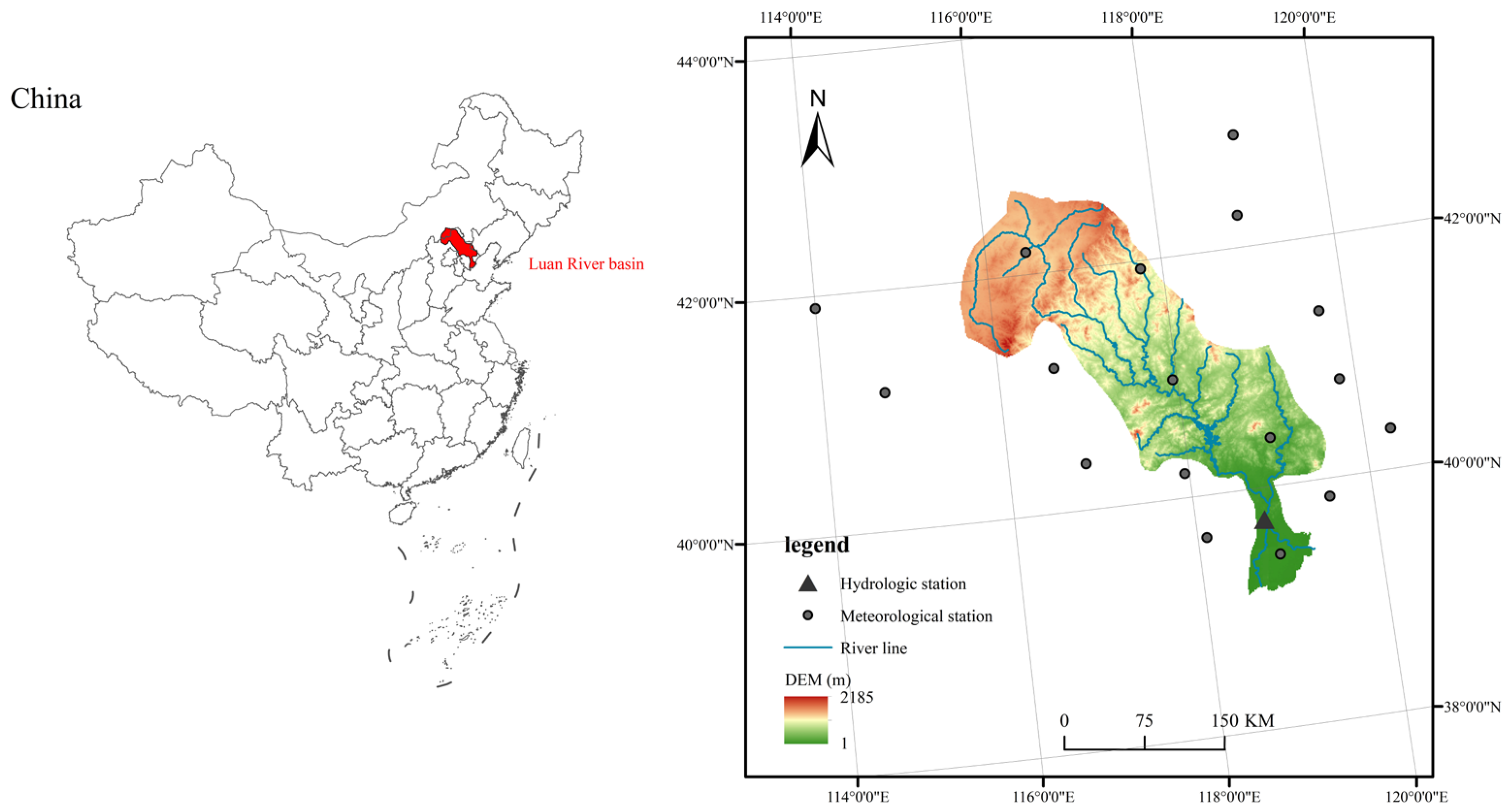
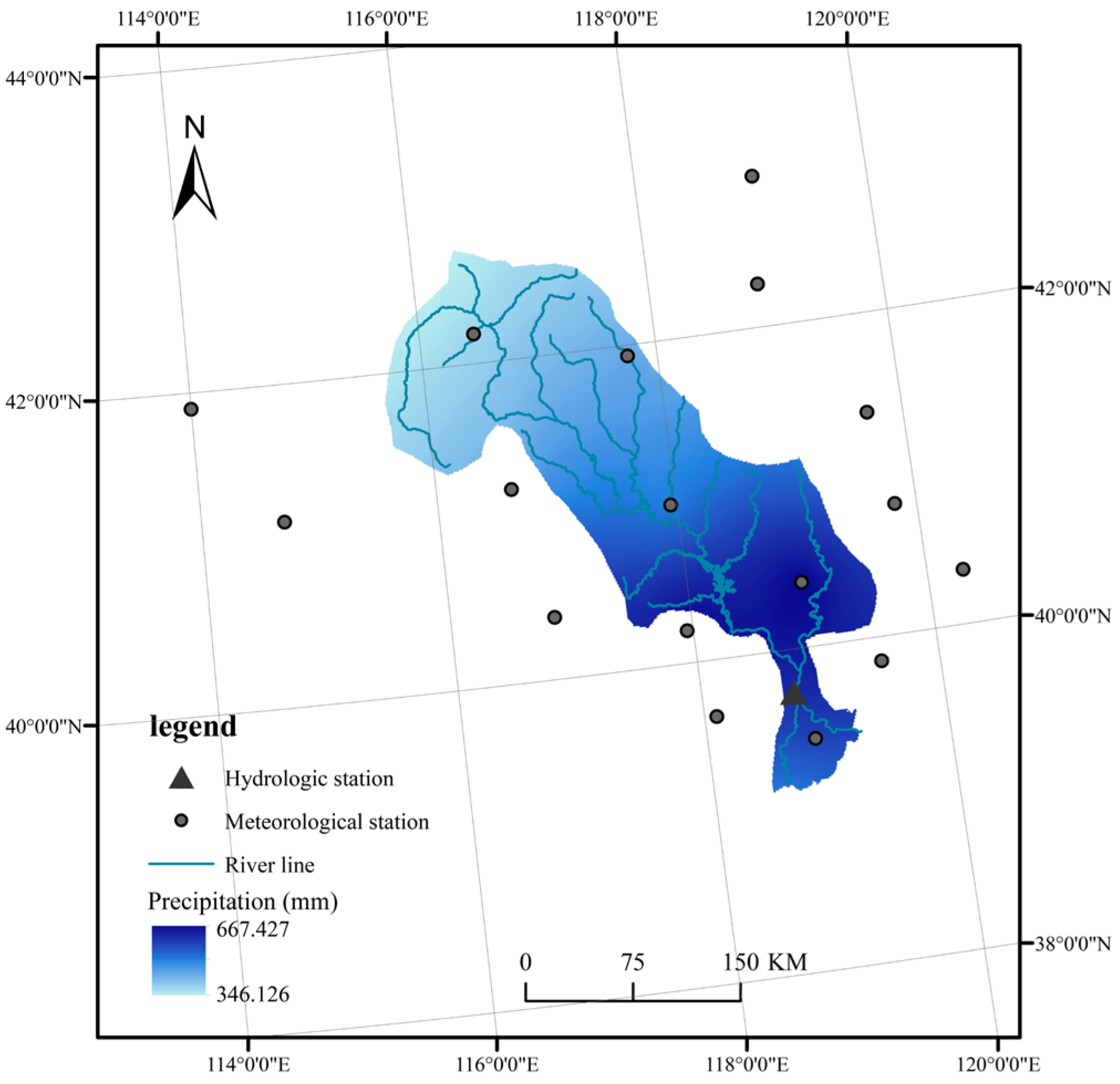

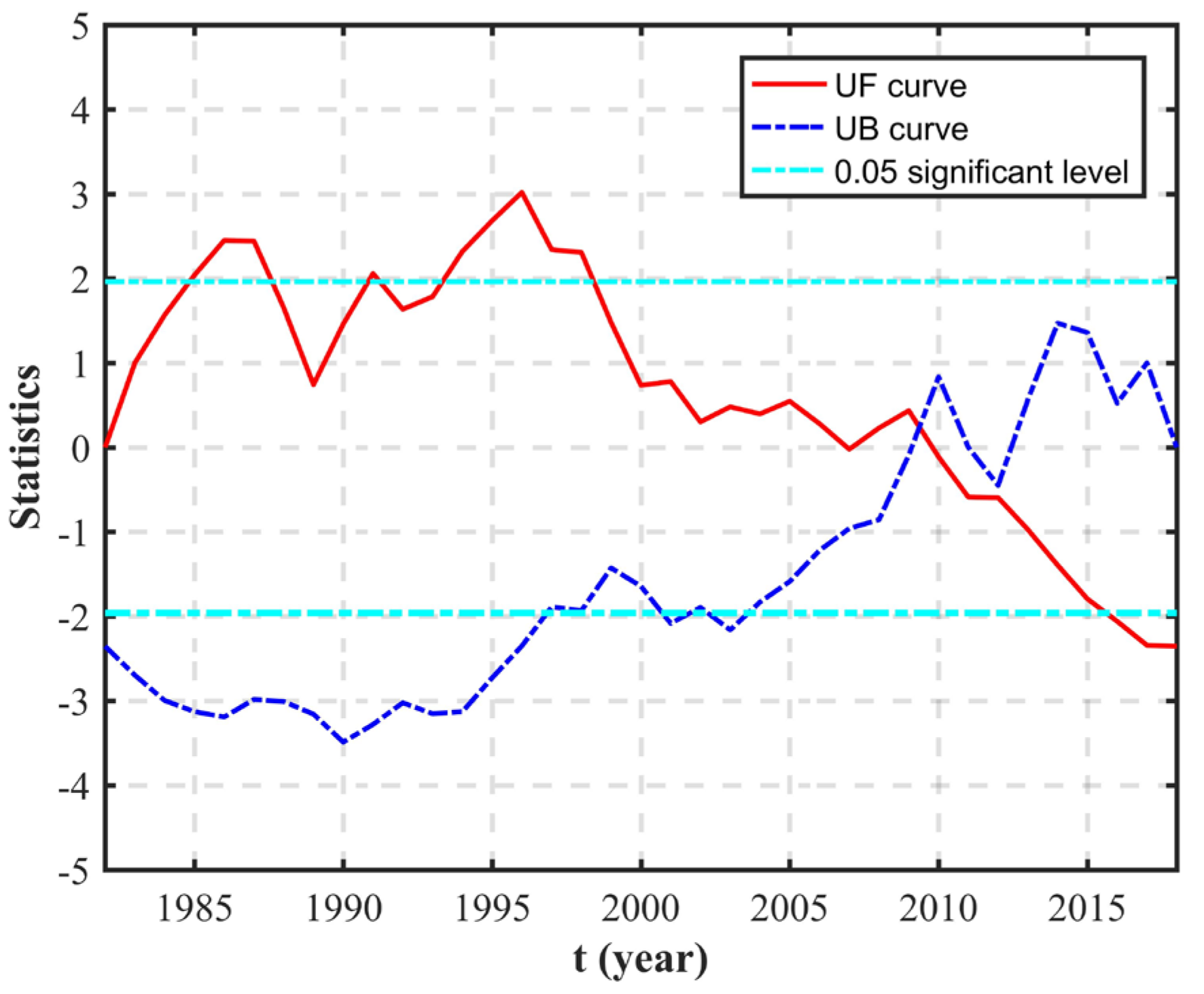
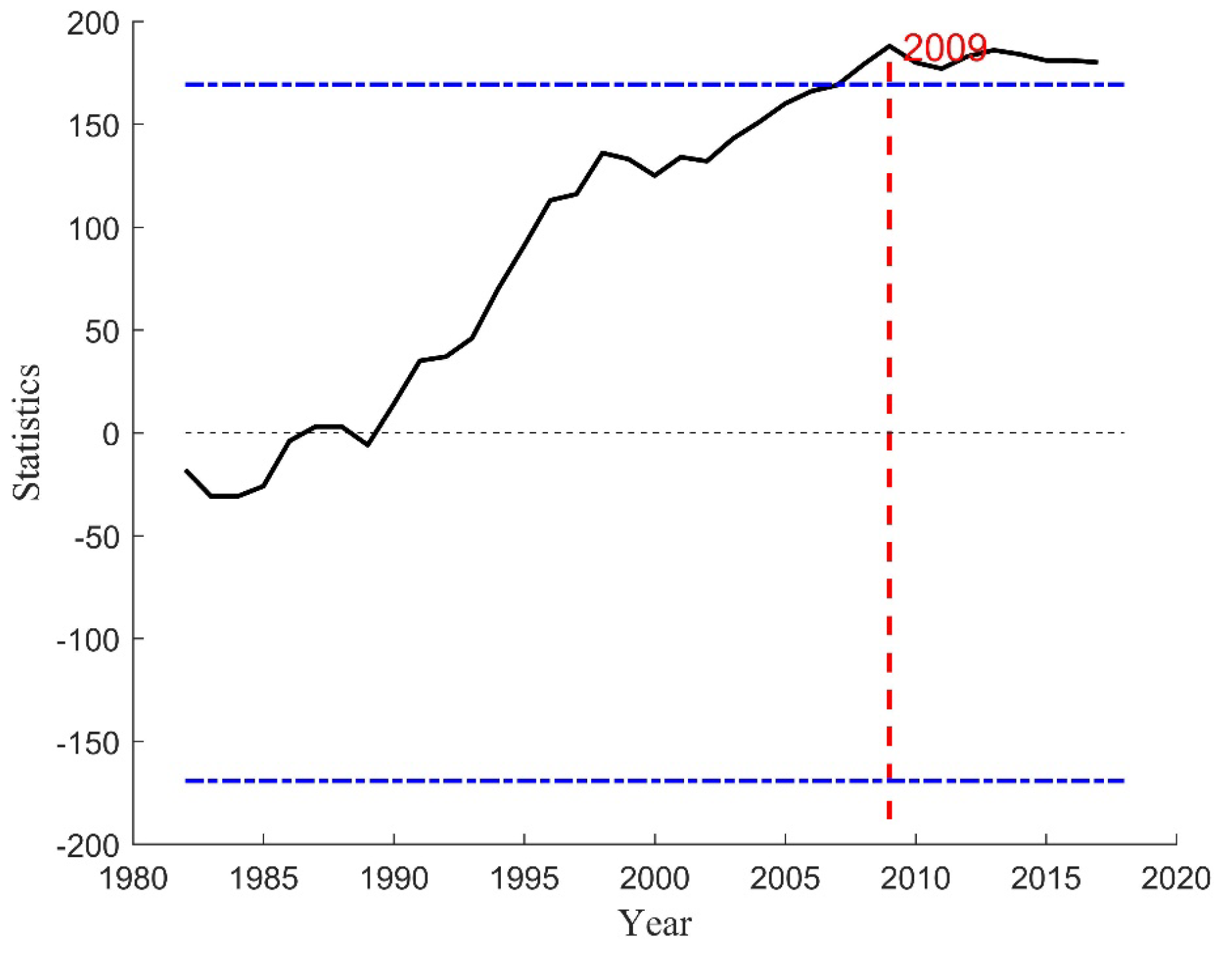
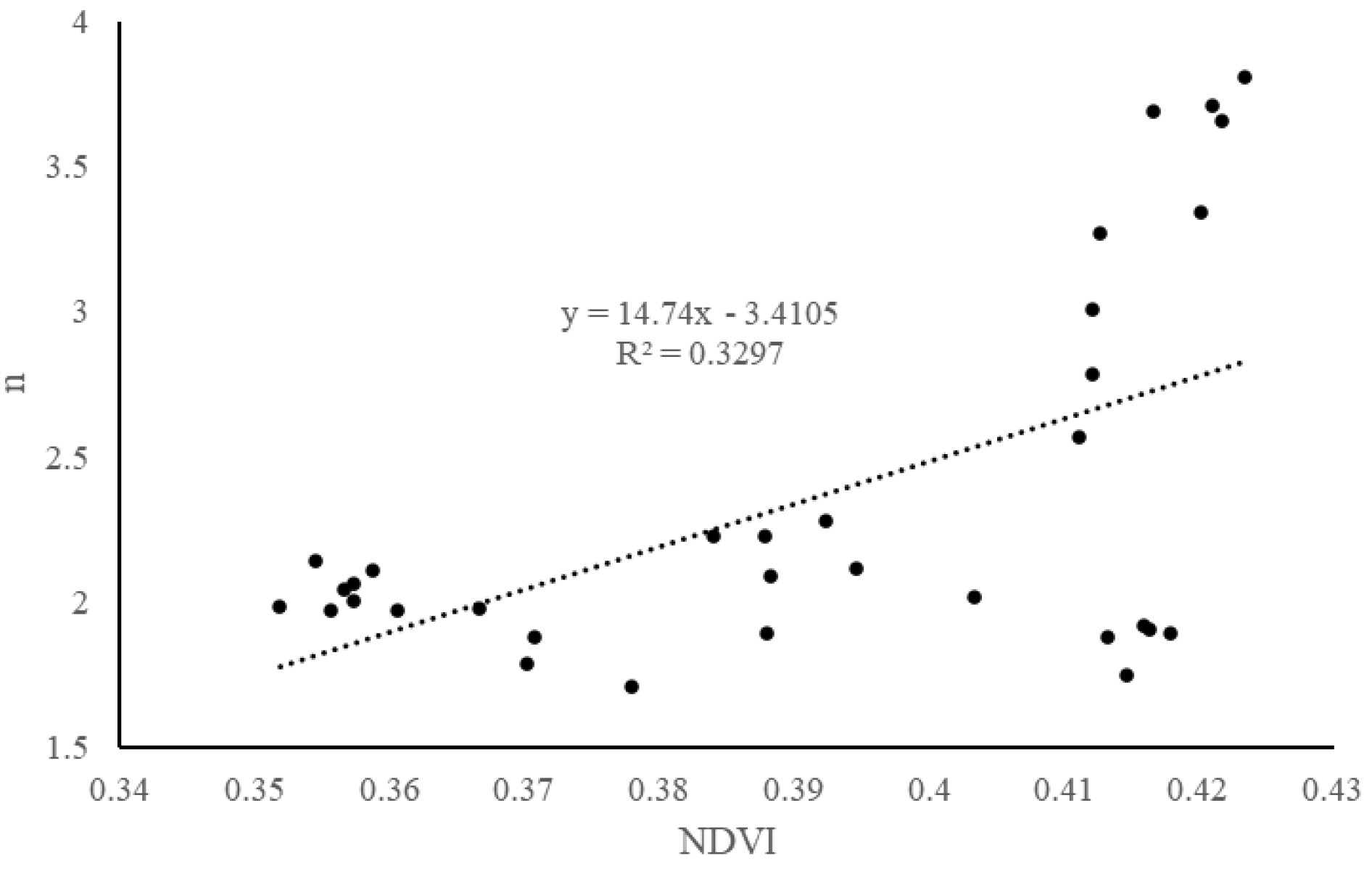
| β | Z Statistic | Significant Level | |
|---|---|---|---|
| R | −1.2437 (mm/a) | −2.3411 | 0.05 |
| P | 0.6977 (mm/a) | 0.6147 | - |
| ET0 | −0.0977 (mm/a) | −0.2354 | - |
| n | 0.0283 | 2.4458 | 0.05 |
| NDVI | 0.0022 | 6.0555 | 0.01 |
| Periods | R/mm | Pr/mm | ET0/mm | NDVI | n |
|---|---|---|---|---|---|
| S1 (1982–2009) | 79.29 | 496.13 | 822.60 | 0.38 | 1.97 |
| S2 (2010–2018) | 30.01 | 531.39 | 829.82 | 0.42 | 3.73 |
| Δ | −49.28 | 35.26 | 7.22 | 0.04 | 1.76 |
| εPr | εE0 | εn | εNDVI | ΔPr | Δ | ΔRNDVI | ΔRhum | ||||
| 2.98 | −1.98 | −1.89 | −4.64 | 14.03 | −1.17 | −28.27 | −64.80 | −17.49% | 1.46% | 35.25% | 80.78% |
Disclaimer/Publisher’s Note: The statements, opinions and data contained in all publications are solely those of the individual author(s) and contributor(s) and not of MDPI and/or the editor(s). MDPI and/or the editor(s) disclaim responsibility for any injury to people or property resulting from any ideas, methods, instructions or products referred to in the content. |
© 2023 by the authors. Licensee MDPI, Basel, Switzerland. This article is an open access article distributed under the terms and conditions of the Creative Commons Attribution (CC BY) license (https://creativecommons.org/licenses/by/4.0/).
Share and Cite
Yue, S.; Huang, J.; Zhang, Y.; Chen, W.; Guo, Y.; Cheng, M.; Ji, G. Quantitative Evaluation of the Impact of Vegetation Restoration and Climate Variation on Runoff Attenuation in the Luan River Basin Based on the Extended Budyko Model. Land 2023, 12, 1626. https://doi.org/10.3390/land12081626
Yue S, Huang J, Zhang Y, Chen W, Guo Y, Cheng M, Ji G. Quantitative Evaluation of the Impact of Vegetation Restoration and Climate Variation on Runoff Attenuation in the Luan River Basin Based on the Extended Budyko Model. Land. 2023; 12(8):1626. https://doi.org/10.3390/land12081626
Chicago/Turabian StyleYue, Shuaijun, Junchang Huang, Yali Zhang, Weiqiang Chen, Yulong Guo, Mingyue Cheng, and Guangxing Ji. 2023. "Quantitative Evaluation of the Impact of Vegetation Restoration and Climate Variation on Runoff Attenuation in the Luan River Basin Based on the Extended Budyko Model" Land 12, no. 8: 1626. https://doi.org/10.3390/land12081626
APA StyleYue, S., Huang, J., Zhang, Y., Chen, W., Guo, Y., Cheng, M., & Ji, G. (2023). Quantitative Evaluation of the Impact of Vegetation Restoration and Climate Variation on Runoff Attenuation in the Luan River Basin Based on the Extended Budyko Model. Land, 12(8), 1626. https://doi.org/10.3390/land12081626









